September 11, 2001 is a date that Americans will never forget.
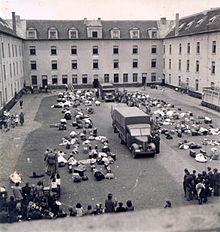 September 11, 1942 is a date that Jews in the north of France will never forget. On that date seventy-five years ago the rafle – or mass round-up – of the area’s Jews took place. Although part of France, the German occupation assigned the administration of Nord-Pas-de-Calais to Brussels.
September 11, 1942 is a date that Jews in the north of France will never forget. On that date seventy-five years ago the rafle – or mass round-up – of the area’s Jews took place. Although part of France, the German occupation assigned the administration of Nord-Pas-de-Calais to Brussels.
At 4:00 a.m. on September 11, Jews, primarily those who were stateless or refugees, were rounded up, sent to a detention area in Mechelen (known as the Belgium Drancy), and then on to the deportation station in Lille, France.
Identifying those targeted for round-up was made simpler because of the relatively recent requirement that area Jews wear a yellow star. The files were up-to-date, making capture easy.
The history of the Jewish population in the area is varied. Towns like Lille and Valenciennes had well established communities going back to the 19th century. However, in Lens, for example, Polish Jews came during the interwar period and settled among the thousands of Poles who had come earlier in the century to work in the coal mines. Jews settled among their Polish countrymen; many established small businesses. However, no love was lost between the two communities.
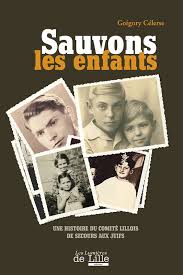 When the round-ups occurred, the Lensois did little to help the Jewish residents. In Lille, however, 24 railway agents saved the lives of almost 80 Jews, mostly children. The youngest was three month old Michel Baran who was smuggled out in a backpack which his family has kept to this day. This little known story was discovered by author Gregory Celerse in a SNCF (French railroad) file being sold at the Wazemmes flea market. He published the story as Save the Children.
When the round-ups occurred, the Lensois did little to help the Jewish residents. In Lille, however, 24 railway agents saved the lives of almost 80 Jews, mostly children. The youngest was three month old Michel Baran who was smuggled out in a backpack which his family has kept to this day. This little known story was discovered by author Gregory Celerse in a SNCF (French railroad) file being sold at the Wazemmes flea market. He published the story as Save the Children.
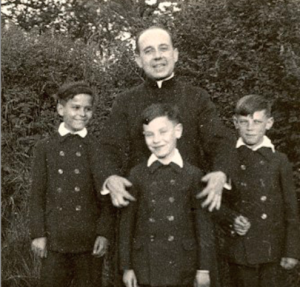 Although almost none of those deported in the rafle survived, there were numerous acts of humanity in Nord-Pas-de-Calais. Many ministers and priests such as Abbot Robert Stahl made arrangements to hide children in orphanages or Catholic institutuions. Brave individuals took families into their homes hiding them wherever they could and risking their lives. An active Resistance, including a branch of the Polish Resistance, was instrumental in this effort.
Although almost none of those deported in the rafle survived, there were numerous acts of humanity in Nord-Pas-de-Calais. Many ministers and priests such as Abbot Robert Stahl made arrangements to hide children in orphanages or Catholic institutuions. Brave individuals took families into their homes hiding them wherever they could and risking their lives. An active Resistance, including a branch of the Polish Resistance, was instrumental in this effort.
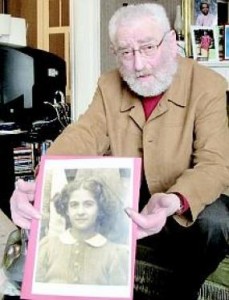 One of these hidden children was Edgard Leser who died in August at the age of 84. He was an active member of the Lille Jewish community and spokesman for interfaith cooperation. Hidden with his younger brother by Abbot Stahl, in his later years Leser spoke at schools in the area. As recently as April, Leser appeared in Paris for the National Day of Remembrance of the Victims and Heroes of the Deportation and said, “Let France, a land of human rights, everywhere defend law and freedom.” (Que la France, pays des droits de l’homme, défende en tout lieu le droit et la liberté.)
One of these hidden children was Edgard Leser who died in August at the age of 84. He was an active member of the Lille Jewish community and spokesman for interfaith cooperation. Hidden with his younger brother by Abbot Stahl, in his later years Leser spoke at schools in the area. As recently as April, Leser appeared in Paris for the National Day of Remembrance of the Victims and Heroes of the Deportation and said, “Let France, a land of human rights, everywhere defend law and freedom.” (Que la France, pays des droits de l’homme, défende en tout lieu le droit et la liberté.)
Because of the efforts of people like Abbot Stahl, 91 people from Nord-Pas-de-Calais have been named as Righteous Among the Nations.
A teacher in the Lille public schools has told me that the Holocaust is taught in the schools. There are survivors such as Lili Rosenberg who has talked to thousands of students about her experiences. She was imprisoned in Ravensbruck where she was a prisoner along with Genevieve de Gaulle, Charles de Gaulles’ neice, and in Bergen Belsen where she worked alongside Simone Weil and Anne and Margot Frank.
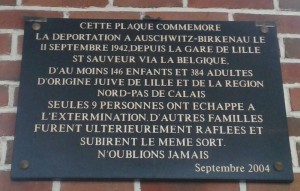 There are memorial plaques around the region including one dedicated last year at the huge, now repurposed Saint Saveur Station from which convoys left. Dedicating the plaque, the mayor’s representative said that the Holocaust was one of the most painful pages in the city’s history. He noted that the station is now a cultural center, a place of festivities, and rejoicing, a perfect place “to carry a message of tolerance and justice, a future-oriented site, a mark of eternal respect and mourning for those children.”
There are memorial plaques around the region including one dedicated last year at the huge, now repurposed Saint Saveur Station from which convoys left. Dedicating the plaque, the mayor’s representative said that the Holocaust was one of the most painful pages in the city’s history. He noted that the station is now a cultural center, a place of festivities, and rejoicing, a perfect place “to carry a message of tolerance and justice, a future-oriented site, a mark of eternal respect and mourning for those children.”
As many gather to mark this solemn day of remembrance, Lille’s children are well into la rentrée scolaire as they begin their second week of school. My 11-year-old granddaughter has just begun collège. College? She’s bright but certainly not ready for higher education. Collège is the French term for middle school. The students are thrown into a vigorous, sometimes almost eight hour school day, filled will mostly academic subjects. Suzanne is in the English section so she has additional hours in that subject.
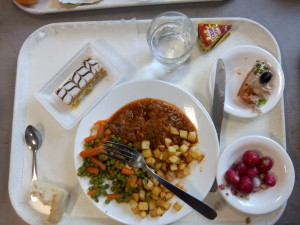 In addition to the academic vigor there are other differences between French and American middle schools. The students have an hour for lunch and they need it. First they stand in line for a ticket to enter the cantine (cafeteria) and then they stand in the food line. But it’s not French fries and hamburgers for these young gourmands. They are served a multi-course meal including an appetizer, cheese, and dessert every day for less than five dollars.The evening meal, needless to say, is usually light. French kids learn that meals are an occasion and that one should not rush through the experience. This applies even to the little kids in preschool. By the way, that’s not plastic-ware on the tray.
In addition to the academic vigor there are other differences between French and American middle schools. The students have an hour for lunch and they need it. First they stand in line for a ticket to enter the cantine (cafeteria) and then they stand in the food line. But it’s not French fries and hamburgers for these young gourmands. They are served a multi-course meal including an appetizer, cheese, and dessert every day for less than five dollars.The evening meal, needless to say, is usually light. French kids learn that meals are an occasion and that one should not rush through the experience. This applies even to the little kids in preschool. By the way, that’s not plastic-ware on the tray.
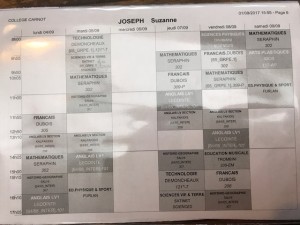 The schedule is different each day and it takes a master organizer to remember which day classes begin at eight and which day classes start as late as noon or on which day there is English and which day there is history.
The schedule is different each day and it takes a master organizer to remember which day classes begin at eight and which day classes start as late as noon or on which day there is English and which day there is history.
Wednesdays there are no classes; students have a half day on Saturdays. There’s no sleeping late on the weekends for Lille students or weekend family getaways.
If a teacher is absent, there is no substitute; the class is simply cancelled and students make the best of the time. Fortunately they are usually informed the day before of a teacher absence.
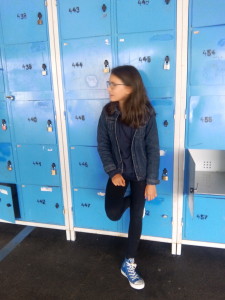 But despite this heavy schedule, Suzanne likes her teachers who seem to use many of the same strategies and techniques as their American counterparts. The students decorate their notebooks, have scavenger hunts, use the internet, make information webs. However, there are no textbooks but lots of photocopied pages and very precise directions on what color and size of notebooks for each of the 10 different classes.
But despite this heavy schedule, Suzanne likes her teachers who seem to use many of the same strategies and techniques as their American counterparts. The students decorate their notebooks, have scavenger hunts, use the internet, make information webs. However, there are no textbooks but lots of photocopied pages and very precise directions on what color and size of notebooks for each of the 10 different classes.
Despite differences, the kids look the same as any middle school group; the girls tower over the boys; the girls whip their long hair around, giggle and whisper; the boys push and shove and yell.
Definitely collège, not college.
See last week’s article – Bordeaux, City of History and Food – for books about the the round up or check your public library for books and media about the topics
- MESH Report April 9, 2024 - Thu, Apr 11, 2024
- Guess Who? - Wed, Mar 13, 2024
- Leftovers - Wed, Mar 6, 2024
